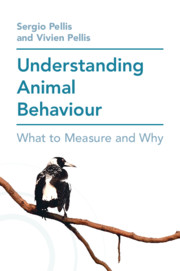Understanding Animal Behaviour
What to Measure and Why
- Authors:
- Sergio Pellis, University of Lethbridge, Alberta
- Vivien Pellis, University of Lethbridge, Alberta
- Date Published: August 2021
- availability: Available
- format: Paperback
- isbn: 9781108705103
Paperback
Other available formats:
Hardback, eBook
Looking for an inspection copy?
This title is not currently available for inspection. However, if you are interested in the title for your course we can consider offering an inspection copy. To register your interest please contact [email protected] providing details of the course you are teaching.
-
All students and researchers of behaviour – from those observing freely-behaving animals in the field to those conducting more controlled laboratory studies – face the problem of deciding what exactly to measure. Without a scientific framework on which to base them, however, such decisions are often unsystematic and inconsistent. Providing a clear and defined starting point for any behavioural study, this is the first book to make available a set of principles for how to study the organisation of behaviour and, in turn, for how to use those insights to select what to measure. The authors provide enough theory to allow the reader to understand the derivation of the principles, and draw on numerous examples to demonstrate clearly how the principles can be applied. By providing a systematic framework for selecting what behaviour to measure, the book lays the foundations for a more scientific approach for the study of behaviour.
Read more- Introduces principles for discerning the organisation of behaviour in a step-by-step fashion, using easily comprehensible explanations and examples throughout
- Provides examples of inter-disciplinary and multi-disciplinary science in action, with examples drawn from various disciplines that study and measure behaviour
- Guides the reader through how to apply a hypothesis-testing approach to identify and describe behavioural units
Reviews & endorsements
'Describing what animals actually do in their normal daily activities was deemed essential by the early naturalists and ethologists. Today, many journals actively discourage publishing such research findings. What the Pellis team accomplishes in this book is to document, based on their and others' extensive experience and accomplishments, that careful description can itself be hypothesis driven and answer research questions that experiments with simple, but convenient, dependent measures cannot. This compact guide elegantly shows how to use modern methods to describe and quantify behaviour and embed findings in the behaviour systems in which they occur. From seemingly simple behaviour patterns such as righting, huddling, and reaching, to fighting, foraging, play, and courtship, the authors provide myriad insights and research guidance. Today, in a rapidly changing world, it is more essential than ever to study how the behaviour of animals is being altered, both in natural communities and in experimental laboratories.' Gordon M. Burghardt, University of Tennessee, USA
See more reviews'The Pellis' little book is a big gift box in which you'll find a trove of crafted ideas and handy examples of how behaviour can be analysed in ways that reveal marvellous, unsuspected dimensions of behavioural organisation. Using some of the “simplest” and most common individual and social acts in animal behaviour, they offer observational and analytic tools for seeing the deep structure of behaviour and how, in some cases, their approach can take us into the brain or out to emergent levels of organisation. Practical for students and researchers, and delightful for science-oriented fans of organisms. Put it on your shelf for repeated openings and explorations.' Jeffrey R. Alberts, Indiana University, Bloomington, USA
'… a fascinating new way of considering animal behavior … This would be a most useful text for any student or researcher of animal behaviors … Highly recommended.' D. C. Marston, Choice Magazine
Customer reviews
17th Oct 2024 by UName-1148247
As the book is not yet published, I could only review the excerpt. This book looks very interesting as it recalls many aspects of animal behaviors that are nowadays currently overlooked. Short papers of hyotphesis testing provide a huge amount of information which provides more buzz than understanding of animal behaviors. As far as I understand it the authors put a considerable emphasis on selection of variables and on sampling them. I share this concern as I've found unfortunate to see methodological sections of scientific papers progressively disappearing. The lists of variables are poorly justified as if they are self-evident. In the same time, there is an unfortunalte re-emergence of the term ethogram, that Tinbergen himself in 1965 has considered in verge of disparition and as early of 1965 unecessary. This a first reaction to a book I already consider as very important to make researchers think more before publishing instead of publishing prior to think.
Review was not posted due to profanity
×Product details
- Date Published: August 2021
- format: Paperback
- isbn: 9781108705103
- length: 166 pages
- dimensions: 228 x 153 x 10 mm
- weight: 0.28kg
- availability: Available
Table of Contents
Preface
Acknowledgements
1. What is the problem and what is the solution?
2. Behaviour as a means, not an end
3.The deep structure of behavior
4. The brain is not alone
5. Bringing it all together: steps in the descriptive process
6. What of the future?
Epilogue
Appendix A. Eshkol–Wachman movement notation and descriptive analysis
Appendix B. Practice, practice, practice
References
Index.
Sorry, this resource is locked
Please register or sign in to request access. If you are having problems accessing these resources please email [email protected]
Register Sign in» Proceed
You are now leaving the Cambridge University Press website. Your eBook purchase and download will be completed by our partner www.ebooks.com. Please see the permission section of the www.ebooks.com catalogue page for details of the print & copy limits on our eBooks.
Continue ×Are you sure you want to delete your account?
This cannot be undone.
Thank you for your feedback which will help us improve our service.
If you requested a response, we will make sure to get back to you shortly.
×










